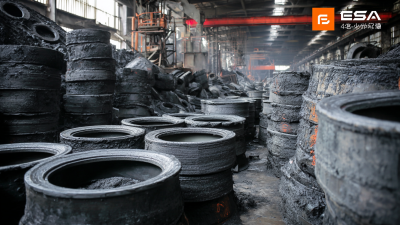The rise of environmental concerns and waste management challenges has intensified the need for innovative solutions, particularly in the realm of tyre disposal. Tyre Shredding Machines play a pivotal role in transforming end-of-life tyres into reusable materials, thereby contributing to sustainable practices in waste management. According to a recent report by the Global Tire Recycling Market, the growth of tyre recycling is projected to expand at a CAGR of 5.6% from 2021 to 2028, highlighting the increasing relevance of tyre shredding technology.
Industry expert Dr. Emily Carter, a leading figure in waste management technology, emphasizes the importance of such machinery, stating, "Tyre shredding machines not only mitigate the environmental impact of tyre waste but also convert it into valuable resources for various industries." The efficient processing capabilities of Tyre Shredding Machines facilitate the recovery of rubber, steel, and textile materials, further promoting a circular economy. As we delve into the complexities of tyre shredding technology, it is imperative to explore its multifaceted impact on both waste management practices and broader sustainability goals.

Tyre shredding machines play a crucial role in the growing field of waste management, particularly in reducing the environmental impact of discarded tyres. With an estimated 1.5 billion tyres being discarded annually worldwide, the necessity for efficient waste reduction strategies has never been more pressing. By converting end-of-life tyres into smaller, manageable pieces, these machines facilitate the recycling and repurposing of rubber materials. A report by the US Environmental Protection Agency (EPA) indicates that approximately 30% of scrap tyres are recycled into crumb rubber, which can be utilized in various applications, such as playground surfaces, asphalt mixtures, and even in products like sports courts and mats.
The advantages of tyre shredding machines extend beyond simply alleviating landfill issues; they also contribute significantly to sustainability practices. A study conducted by the European Tyre Recycling Association (ETRA) shows that tyre shredding can reduce waste volume by up to 75%. This reduction not only conserves space in landfills but also diminishes the adverse environmental effects associated with tyre degradation, such as leachate and greenhouse gas emissions. Furthermore, recycled rubber created from shredded tyres can replace natural materials in numerous industrial processes, thus promoting a circular economy and reducing the reliance on virgin resources. As industries and municipalities increasingly adopt these innovative waste management technologies, the potential for sustainable practices continues to expand.
Innovative tyre shredding technologies play a pivotal role in enhancing recycling processes within the waste management sector. As reported by the Environmental Protection Agency (EPA), around 300 million used tyres are generated annually in the United States alone, with less than 20% being recycled effectively. Modern tyre shredding machines enable the efficient processing of these waste tyres, breaking them down into smaller, manageable pieces that can be repurposed into various products such as rubber mulch, asphalt, and even new tyre manufacturing. By improving the shredder's capabilities — including precision and energy efficiency — these technologies not only streamline the recycling process but also contribute to significant reductions in landfill waste.

Tips for optimizing the use of tyre shredding machines include regular maintenance to ensure peak performance, monitoring energy consumption to reduce operational costs, and investing in quality equipment that can handle diverse tyre types. Additionally, companies can collaborate with local recycling facilities to create a more integrated approach to tyre waste management, fostering a circular economy that benefits both the environment and the community. By adopting these innovative practices, businesses can significantly enhance their recycling efforts and promote sustainable waste management solutions.
The implementation of tyre shredding machines in waste management presents significant environmental benefits that contribute to sustainable practices. One of the primary advantages is the reduction of landfill waste. By shredding used tyres, which are otherwise challenging to dispose of, we can decrease the volume of waste that occupies landfills, thus extending their lifespan and mitigating potential environmental hazards.
Moreover, shredded tyres can be repurposed for various applications, such as in the production of rubberized asphalt for roads, erosion control materials, and playground surfaces. This not only minimizes the reliance on virgin materials but also promotes a circular economy where resources are reused and recycled. Additionally, the process of shredding tyres helps to eliminate harmful substances that may leach into soil and water when tyres are disposed of improperly, thereby protecting local ecosystems and public health. Overall, the adoption of tyre shredding technology aligns with environmental sustainability goals and fosters greater efficiency in waste management systems.
This chart illustrates the environmental benefits associated with the implementation of tyre shredding in waste management practices. It highlights key metrics such as recycling rate, landfill reduction, carbon emission reduction, and energy recovery, each demonstrating the positive impact of tyre shredding on sustainable waste management.
The tire recycling market is poised for significant growth, spurred by an increasing emphasis on
sustainable waste management practices. With projections indicating that the market could reach a valuation of
$19.24 billion by 2033, the economic impacts of tire shredding machines on the
circular economy are becoming increasingly evident. These machines not only facilitate the efficient processing of end-of-life tires but also create
valuable raw materials for various industries, thereby contributing to a more
sustainable economy.
Moreover, the adoption of advanced recycling technologies, such as pyrolysis, demonstrates how innovation can turn
waste into economic opportunity. Companies focusing on these technologies are
aligning with global sustainability efforts and supporting the circular economy model. As stakeholders in this sector advocate for
extended producer responsibility and government incentives, the potential for tire shredding
machines to play a pivotal role in environmental management and economic development continues to grow.
Tyre shredding machines have emerged as pivotal tools in transforming waste management practices, significantly contributing to sustainable development. A notable example can be seen in the case of Eco Tire Recycle, which processes over 100,000 tonnes of used tyres annually. By employing shredder technology, they not only reduce the volume of waste tyres but also recover valuable materials, including steel and rubber. According to the Rubber Manufacturers Association, every ton of recycled rubber can save up to 1.2 barrels of oil, underscoring the environmental benefits of tyre shredding.
Another successful application can be found in the construction industry, where shredded tyres are increasingly utilized in lightweight fill applications. The International Journal of Environmental Science and Technology reported that replacing traditional materials with shredded tyre aggregate can reduce the overall project costs by approximately 30% while also enhancing drainage and decreasing landfill burdens. Moreover, using tire-derived materials in road construction has shown a reduction in noise pollution, further demonstrating the multifaceted advantages of these sustainable practices. The integration of tyre shredding technologies presents a clear path toward effective waste management and resource recovery.







